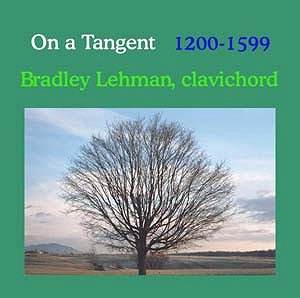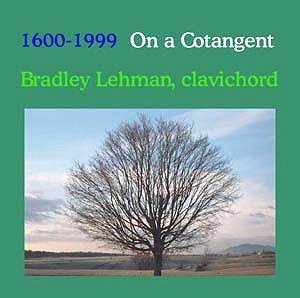Bradley Lehman is a proponent of the clavichord, and
here has produced and recorded two CDs on this unique instrument. As
he says in his liner notes, "The clavichord is the simplest keyboard
instrument, dating from as early as the 14th Century. Its expression
ranges from gentle delicacy to fiery abruptness. It is well suited to
most of the keyboard literature without pedal, and (as demonstrated
here) to music borrowed from other instruments. Its most popular use
historically has been as a home instrument, especially for practice
by organists and harpsichordists."
Indeed, Bach is said to have used clavichords to practice
at home, and organists often practiced on clavichords as well, since
an organ is not something you could play outside of a church. The clavichord
has a unique sound, somewhere between a steel-stringed guitar and a
harpsichord. Yet it a very soft instrument, because the strings are
struck rather than plucked. As Lehman points out, "For an accurate
representation of the clavichord's tone, please set your volume controls
VERY LOW. The clavichord is an especially quiet instrument, producing
barely a whisper of sound. If the playback volume is too high, some
of these performances sound far more intense than they are in real life!"
The first disc, On a Tangent, presents a selection
of pieces from 1200 - 1599. Not all of these pieces were intended to
be played on the clavichord; actually, very little music was expressly
written for this instrument. At the time, it was sufficient to say that
a given piece was written for the keyboard, and those playing it could
use a harpsichord, clavichord, spinet, virginal or other instrument.
Some of the works on this disc are lively, such as
the admirable Quando claro, a brief, rapid improvised dance piece. You
can almost imagine the characters of a Breughel painting spinning around
in joy to this music, or to other dance pieces, such as Holloyne pardye,
which, according to the liner notes, is 16th century rough-and-ready
Halloween party music. These pieces give the disc a lively, festive
atmosphere. In fact, it sounds as though Lehman searches above all to
create an atmosphere - the sequence and choice of pieces is intended
to act as a more global discourse presenting a variety of music.
Some of the works are slower, more delicate, such as
Guardame las vacas, a series of variations on a folk song, which has
the tone of much Elizabethan lute music, or the Ricercar (Fantasia)
3 in G, by Luys Milan, which recalls some of Byrd's keyboard music.
The second disc, On a Cotangent, contains a wider variety
of pieces. It stretches from 1600 to 1999, and ranges from a piece by
Orlando Gibbons to traditional Irish songs, to compositions by Lehman
himself. The long set of variations by Georg Böhm, Wer nur den
lieben Gott lässt walten, is a fine example of how baroque music
can fit the clavichord perfectly. The dynamics and texture of the piece
make it sound as though it was truly written for this instrument.
O Haupt voll Blut und Wunden is an arrangement of three
settings of the same text: a four-part vocal version from Bach's Christmas
Oratorio, an organ prelude by Johann Pachelbel, and an organ harmonization
from Samuel Scheidt's Görlitzer Tabulaturbuch (1650). This is a
beautiful arrangement, showing the variety of manners in which the same
text was approached in the baroque period.
There are familiar pieces, such as the Minuets in G
and G Minor from Anna Magdalena Bach's keyboard book (written by Christian
Petzold). Most students of keyboard music have played these pieces,
and, on the clavichord, they take on a much more homey sound, which
is probably similar to that heard in Bach's house.
The Three Polonaises by Carl Philipp Emanuel Bach are
works by Bach's best-known son, who was a proponent of the clavichord,
and who wrote a great deal of music expressly for this instrument.
There are other more contemporary pieces, showing the
full range of the clavichord - a traditional Irish song, The Foggy Morn,
a traditional Japanese song, Sakura canons, arranged by Lehman, and
a rag by Debussy, Le petit nègre.
All in all, these two discs are fine examples of the
little-known instrument, the clavichord. Its unique sound is indeed
something that all music-lovers should discover. Bradley Lehman gives
two wonderful anthologies of music for this instrument, which are delightful
in both melody and sound. These self-produced discs also show the excellent
quality that can be obtained by individuals with talent and appropriate
technical conditions. I give these discs a very high recommendation,
and hope that more listeners will discover this instrument.
Kirk McElhearn
CONTACT DETAILS
http://www-personal.umich.edu/~bpl/cds.html




![]() Bradley Lehman,
clavichord
Bradley Lehman,
clavichord ![]() MP3.COM 70078
(1) 70125 (2)
MP3.COM 70078
(1) 70125 (2)